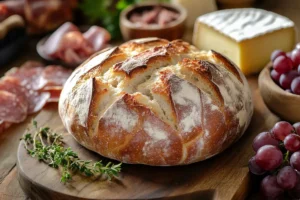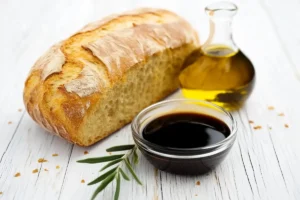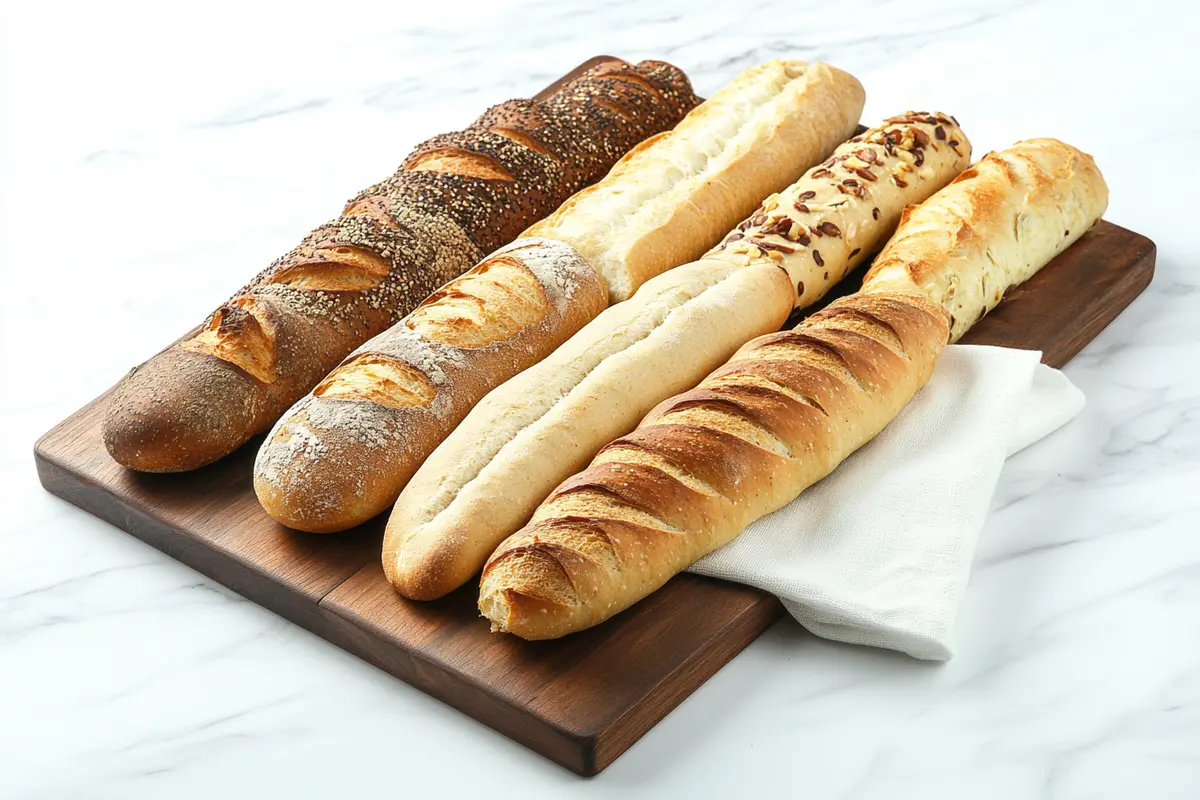Introduction To Long Bread
Understanding
Long bread isn’t just bread—it’s a global sensation. From the iconic French baguette to rustic ciabattas, distinguishes itself by its elongated shape, crusty exterior, and tender crumb. People around the world rely on for everyday meals, gourmet dining, and everything in between.
Definition and Characteristics
What exactly is long bread? Generally, it refers to bread loaves with an extended, narrow shape. Its crust is typically crunchy and golden brown, while the inside remains soft and airy. The high hydration levels in the dough and steam baking are key techniques that contribute to its distinctive texture and appearance. Unlike round loaves, long bread’s shape makes it ideal for slicing into even portions, perfect for sandwiches or sides.
Historical Origins
The roots of long bread date back thousands of years, with early variations appearing in ancient Egypt and the Roman Empire. However, it was in Europe—particularly France and Italy—that long bread as we know it today flourished. French bakers perfected the baguette in the early 20th century, while Italians developed ciabatta as a rustic alternative to traditional loaves. Each culture added its own flair, making long bread a diverse yet universally loved culinary creation.
Cultural Significance of Long Bread Across the Globe
Long bread transcends borders, bringing its unique charm to different cuisines. In France, it’s a daily staple, often enjoyed with butter and jam for breakfast. Italy takes pride in ciabatta, a versatile loaf that complements soups, salads, and charcuterie boards. Meanwhile, In Germany, long bread rolls like Brötchen have become breakfast essentials. Read about the name of the long bread roll. The worldwide appeal reflects not only its versatility but also its ability to connect people across cultures.
Varieties of Long Bread
Popular Types
The world of long bread is vast, offering diverse options to suit every palate. From the iconic French baguette to rustic Italian ciabatta, each type has a distinct flavor, texture, and story. Let’s explore some of the most beloved long breads and what makes them unique.
Baguette: The Quintessential French Long Bread

When you think of long bread, the baguette likely comes to mind first. This iconic French creation, known for its crispy crust and airy interior, is deeply ingrained in French culture. Traditionally made with just four ingredients—flour, water, yeast, and salt—the baguette is a testament to the beauty of simplicity.
Its elongated shape and golden crust make it versatile for meals. A fresh baguette pairs beautifully with butter, cheese, or soups. Fun fact: French law strictly regulates baguette production, ensuring its authenticity, as highlighted in the Comprehensive Guide to French Breads. To learn more about French bread traditions, explore the Comprehensive Guide to French Breads.
Ficelle: A Thinner Variation of the Baguette

For those who enjoy lighter options, the ficelle is a delight. Its name, meaning “string” in French, reflects its thin and delicate structure. The ficelle boasts a crispy exterior similar to the baguette but contains less bread overall, making it perfect for appetizers or charcuterie platters.
Its slender form ensures quick baking, and it’s often seasoned with herbs or seeds for added flavor. Despite being less known globally, ficelle holds a special place among French bakers for its unique charm.
Italian Ciabatta: A Rustic Long Loaf

Ciabatta, with its chewy texture and open crumb, hails from Italy. This rustic long bread is made with high-hydration dough, resulting in its characteristic holes and irregular shape. Unlike the uniform baguette, ciabatta has a more rugged appearance, often dusted with flour.
Its versatility makes it a favorite for sandwiches like panini or simply as a side with olive oil and balsamic vinegar. If you’re looking to experiment with textures, ciabatta is a must-try. Discover more about bread types at the Live Eat Learn Guide to Bread.
German Brötchen: Versatile Long Bread Rolls
Germany brings its own spin to long bread with Brötchen, a smaller, roll-shaped variant. These bread rolls are often served for breakfast, paired with butter, jam, or cold cuts. While they aren’t as elongated as the baguette or ciabatta, their flavor and texture offer the same satisfying crunch and chew.
Brötchen’s adaptability lies in its size and texture, making it a staple in German households. Whether enjoyed fresh from the oven or reheated, this bread roll complements a variety of dishes.
Baking Techniques
Essential Ingredients
The magic of long bread lies in its simplicity, requiring just a handful of ingredients to achieve perfection. Yet, the quality of these ingredients is crucial. Here’s what you’ll need:
- Flour: Bread flour is ideal for its high gluten content, which provides the elasticity and structure needed for long bread.
- Water: Purified or filtered water helps avoid any off-flavors from tap water.
- Yeast: Active dry or instant yeast gives the bread its lift and airy texture.
- Salt: Enhances flavor and strengthens the dough’s structure.
- Optional Add-ins: Seeds, herbs, or garlic can add personality to your loaf.
The right balance of these ingredients, combined with proper techniques, sets the stage for baking success. Learn more about the difference between shortbread and long bread.
Step-by-Step
Baking long bread at home might seem intimidating, but with patience and practice, anyone can master it. Follow these steps for a foolproof experience:
- Mix the Dough: Combine flour, water, yeast, and salt in a mixing bowl. Stir until the dough comes together, then knead until it’s smooth and elastic.
- First Rise: Place the dough in a lightly oiled bowl, cover it with a damp cloth, and let it rise until it doubles in size (about 1-2 hours).
- Shape the Dough: Punch down the risen dough, then divide and shape it into long loaves. For baguettes, roll the dough into thin, elongated shapes.
- Second Rise: Allow the shaped dough to rest and rise again on a floured surface, covered, for 30-45 minutes.
- Score the Bread: Use a sharp blade to make diagonal cuts on the surface. This step allows the bread to expand evenly during baking.
- Bake with Steam: Preheat your oven to a high temperature (around 475°F/245°C) and place a pan of water on the bottom rack to create steam. Bake until the crust is golden brown and crisp.
- Cool Completely: Let the cool on a wire rack before slicing to maintain its structure and crumb.
Tip: For added flavor, experiment with sourdough starters or extended fermentation processes.
Common Mistakes to Avoid
Even experienced bakers can encounter hiccups when crafting long bread. Here are some common pitfalls and how to sidestep them:
- Using Incorrect Flour: Opt for bread flour instead of all-purpose for better elasticity and rise.
- Overproofing the Dough: Allowing the dough to rise too long can cause it to deflate during baking.
- Skipping Steam: Without steam, the crust can become overly tough or dry.
- Cutting While Hot: Slicing too soon can ruin the bread’s texture—patience is key!
For beginners, check out this Beginner’s Guide to Baking Artisan Bread for more tips and tricks.
Nutritional Aspects of Long Bread
Nutritional Profile
Long bread comes in many forms, each offering a unique nutritional composition. While primarily a source of carbohydrates, its nutritional value varies depending on the ingredients and preparation method. Here’s a breakdown of common types:
- Baguette: Made with basic ingredients, a classic baguette is low in fat and cholesterol. However, it is high in carbohydrates, providing quick energy.
- Ciabatta: Thanks to its high hydration dough, ciabatta is slightly denser in calories and carbohydrates but remains a low-fat option.
- Ficelle: Similar to a baguette but smaller, ficelle offers similar nutrition in a more portion-controlled size.
- Brötchen: Often enriched with seeds or grains, Brötchen can provide added fiber and essential minerals like magnesium and zinc.
Despite being a high-carb food, long bread can fit into a balanced diet when consumed in moderation and paired with nutrient-rich toppings. Curious to know what is the long bread called?.
Health Benefits and Considerations
Eating long bread isn’t just about indulging in its delightful flavors—it can also support a well-rounded diet when approached thoughtfully.
Health Benefits:
- Energy Boost: As a carbohydrate-rich food, long bread provides a quick and reliable source of energy, making it ideal for active lifestyles.
- Minimal Additives: Traditional recipes often rely on just a few natural ingredients, avoiding preservatives found in many store-bought loaves.
- Versatility in Pairings: Combining long bread with high-protein or fiber-rich foods like hummus, avocado, or lean proteins creates a more balanced meal.
Considerations:
While long bread has its benefits, there are a few factors to keep in mind:
- Refined Flour Content: Most types of long bread use refined flour, which lacks the fiber and nutrients of whole grains. For a healthier option, look for whole-grain or multigrain variations.
- Portion Control: With its irresistible flavor and texture, it’s easy to overindulge. Stick to reasonable servings to avoid excessive calorie intake.
- Sodium Levels: Some recipes, especially for commercial loaves, can be higher in sodium. Opt for homemade versions to manage salt content.
For those looking for ways to balance taste and nutrition, consider experimenting with sourdough versions or incorporating whole-grain flours into your baking. This not only boosts nutritional value but also enhances the flavor profile.
Nutritional Content of Long Bread (Per 100g)
| Nutrient | Amount |
|---|---|
| Calories | 270 kcal |
| Carbohydrates | 50 g |
| Protein | 8 g |
| Fat | 1 g |
| Dietary Fiber | 2 g |
| Sugar | 1 g |
| Sodium | 490 mg |
This table highlights the nutritional aspects of long bread, showcasing how it can fit into a balanced diet with mindful consumption and creative pairings.
Long Bread in Culinary Applications
Traditional Dishes Featuring Long Bread
Has stood the test of time as a staple in countless cuisines. Its elongated shape and sturdy structure make it ideal for a variety of traditional dishes that showcase its versatility. Let’s explore some culinary classics where long bread takes center stage:
- French Tartines: These open-faced sandwiches are a hallmark of French cuisine. A slice of crispy baguette serves as the perfect base for toppings like butter, jam, or savory pâtés.
- Italian Panini: Ciabatta is a star in Italian kitchens, forming the foundation for grilled panini sandwiches stuffed with ingredients like mozzarella, tomatoes, and basil.
- German Brötchen with Butter and Jam: Brötchen, a popular breakfast item, is traditionally enjoyed with simple spreads such as butter or fruit preserves, highlighting the bread’s natural flavor.
- Garlic Bread: Long bread varieties, like baguettes, are often transformed into this beloved side dish. Sliced, buttered, and infused with garlic and parsley, it’s a favorite accompaniment to soups and pasta dishes.
These dishes showcase how long bread has become an integral part of culinary traditions worldwide, offering comfort and deliciousness in every bite.
Innovative Uses of Long Bread in Modern Cuisine
The versatility of long bread extends beyond its traditional uses. Modern chefs and home cooks alike are constantly experimenting with creative ways to incorporate it into contemporary recipes. Here are a few innovative ideas:
- Bread Bowls: Hollow out a ciabatta loaf to create an edible bowl perfect for serving creamy soups, chili, or dips.
- Stuffed Baguettes: Slice a baguette lengthwise, hollow out the center, and stuff it with ingredients like roasted vegetables, cheese, or deli meats. Wrap and bake for a warm, gooey treat.
- Long Bread Pizza: Use a split baguette or ciabatta as a crust alternative for pizza. Top with marinara, cheese, and your favorite toppings before baking.
- Sweet Long Bread Desserts: Transform leftover long bread into a decadent dessert like bread pudding or French toast. Ciabatta’s chewy texture is particularly suited for soaking up custard.
Pairing Long Bread with Global Flavors
Long bread’s neutral flavor makes it an ideal vehicle for a variety of cuisines. Pair it with global flavors to create exciting new dishes:
- Mediterranean: Serve ciabatta with hummus, tzatziki, or roasted vegetables for a fresh and healthy appetizer.
- Asian: Use sliced baguette to serve Vietnamese Bánh mì sandwiches filled with pickled vegetables and marinated meats.
- Mexican: Create tortas with Brötchen rolls, stuffed with refried beans, avocado, and spicy meats.
These modern applications showcase the endless possibilities of long bread, proving it’s not just a side but often the star of the meal.
Frequently Asked Questions (FAQs)
Some pitfalls to steer clear of include:
Skipping the second rise: This step is crucial for developing shape and texture.
Underproofing: Leads to dense bread that doesn’t rise properly in the oven.
Over-kneading: Creates a tight crumb and reduces the airy texture typical of long bread.
By following a methodical approach, even beginners can bake perfect loaves.
Absolutely! While tools like a baguette pan or baking stone help achieve professional results, you can bake long bread with basic kitchen tools. Use a regular baking tray lined with parchment paper and a shallow pan filled with water to create steam in the oven. A sharp knife or razor blade can substitute for a bread lame to score the dough.
To keep long bread fresh, wrap it loosely in a clean kitchen towel and store it at room temperature for up to two days. Avoid plastic bags, as they trap moisture and make the crust soggy. If you need to extend its life, freeze the in an airtight bag. When ready to enjoy, reheat in the oven for a few minutes to restore its crispy crust.
A baguette is renowned for its distinct characteristics: a golden, crispy crust and a soft, airy interior. Unlike ciabatta, which has a chewy texture and open crumb, or ficelle, which is thinner and lighter, a baguette strikes a balance with its classic size and uniform shape. French laws also regulate its production, ensuring authenticity and tradition.
Conclusion
From its humble origins to its place as a culinary staple worldwide, has earned its reputation as one of the most beloved types of bread. Its versatility, unique textures, and ability to complement a wide variety of dishes make it a kitchen essential. Whether you’re savoring a classic baguette with butter, baking ciabatta for sandwiches, or exploring modern recipes like stuffed breads and bread bowls, offers endless possibilities.
Baking long bread at home provides not only the satisfaction of mastering an art but also the joy of creating something that connects cultures and traditions. Its straightforward ingredients and customizable methods mean anyone can try their hand at crafting this timeless loaf. And let’s not forget its nutritional aspects, which can be tailored to suit individual preferences by experimenting with whole-grain flours or sourdough starters.
Ultimately, long bread is more than just a side to meals—it’s a symbol of comfort, community, and creativity. Whether enjoyed fresh from the bakery, baked at home, or incorporated into innovative dishes, it continues to inspire cooks and bakers across the globe.

